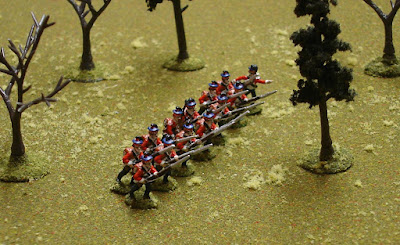The 71st Regiment of Foot was raised in 1775 among the Highlanders of Scotland; it was the first British regiment to be raised after the start of the war. At its peak, the regiment had 2,340 men. The regiment was sent to New York in 1776 and participated in the battle of Long Island, and served in a minor capacity at White Plains and Fort Washington. The following spring (1777), the regiment was active in New Jersey and fought at Short Hills; that summer, the 71st accompanied William Howe to Pennsylvania, where it fought at Brandywine. Afterwards, the regiment was used to guard the British baggage and to help secure the Delaware River. The regiment returned to New York in December, 1777. While in New York, the 71st participated in the raid on Little Egg Harbor, New Jersey (1778), and the grenadiers of the regiment were captured at Stony Point (1779). The 71st participated in the capture of Savannah (1778), and Augusta (1779) in Georgia. In that same campaign it served with distinction at Briar Creek, Stono Ferry, and the siege of Savannah (1779). The following year (1780), the 71st participated in the siege of Charleston and was garrisoned at Cheraws, South Carolina, when the British established a system of outposts in that state.
The 71st suffered significant losses in 1779-1780 due to illness. Captain Johann Ewald of the Hessian Jaegers recorded in his diary (February 2, 1780) that "The remainder of the 71st Scottish Regiment, which had arrived from Savannah, joined us here [near Charleston]. The regiment had melted away during this war from three thousand to four hundred men, due partly to the sword and partly to the climate."
The 71st was placed in reserve at Camden (1780), and helped repel the Continentals when the British left began to gave way. Subsequently, the regiment participated in Cornwallis' abortive invasion of North Carolina, and was present at the capture of Charlotte (1780). The 1st battalion of the 71st and the light infantry of both battalions were destroyed at Cowpens. The 2nd battalion fought at Wetzell's Mill and Guilford Courthouse (1781), and was captured at Yorktown (1781).
The images below show my 1st battalion of the 71st advancing into action. The uniform is based on the Troiani painting of an infantryman of the 71st in the South. Among the miniatures is a bagpiper (wearing a enlisted man's coat with some lace added to the shoulders rather than a proper musician's uniform). Colonel Otho Williams mentioned in a letter that the bagpipes of the 71st were captured at Cowpens.
Feud with Tarleton
Immediately after Cowpens, a long-running feud began between Tarleton and the officers of the 71st. Lieutenant-Colonel John Eager Howard of the Maryland continentals recalled that the captured, "Major M'Arthur [of the 71st] very freely entered. into conversation, and said that he was an officer before Tarleton was born; that the best troops in the service were put under 'that boy' to be sacrificed." Brigadier-General William Moultrie of South Carolina heard the paroled British officers echoing these sentiments after their arrival in Charleston, where they awaited to be exchanged for American prisoners of war. He recalled, "Some of the old British officers who were made prisoners, and paroled to Charlestown, when they came down, were exceedingly angry indeed, at their defeat, and were heard to say, 'that was the consequence of trusting such a command to a boy like Tarleton.'" David Stewart's 1822 Sketches... of the Highlanders of Scotland related that, "if they [the 71st] had been properly led on and supported, they would have shown themselves at Cowpens the same as in all other actions... The troops were hurried into action, without any previous examination of the ground, or of the disposition of the enemy; and so strong was the impression on the minds of the officers of the Highland regiment that the fault did not lie with their men, that they made a representation to Lord Cornwallis, not to be employed again under the same officer. His Lordship complied with their request." The feud reached its climax with the attacks of Lieutenant Roderick's Mackenzie on Tarleton. The first of these appeared in a London newspaper while the war was still in progress. In this, Mackenzie complained to Tarleton that, "You got yourself and your party completely ambuscaded, completely surrounded, upon all sides, by Mr. Morgan's rifle men. What was the consequence? The two detachments of British were made prisoners after a great slaughter was made among them, your legion dragoons were so broke by galling fire of rifle shot that your charging was in vain, till prudence, on your side, with about twenty men who were well mounted, made your retreat good, by leaving the remains of the poor blended legion in the hands of Mr. Morgan."
Sources:
Philip R. N. Katcher (1973). Encyclopedia of British, Provincial, and German Army Units 1775-1783. Stackpole Books.
Johann Ewald (1979). Diary of the American War: A Hessian Journal. Translated by Joseph P Tustin. New Haven: Yale University Press.
John Moncure's online history of the battle, The Cowpens Staff Ride and Battlefield Tour, includes a transcription of statements by Tarleton, Cornwallis, Howard, and Mackenzie's August 9, 1782, letter in the London Morning Chronicle.
William Moultrie's 1802 Memoirs of the American Revolution.
A summary of the Otho Williams papers can be found here. The item in question is a letter from Williams to Dr. James McHenry, dated January 23, 1781.


No comments:
Post a Comment